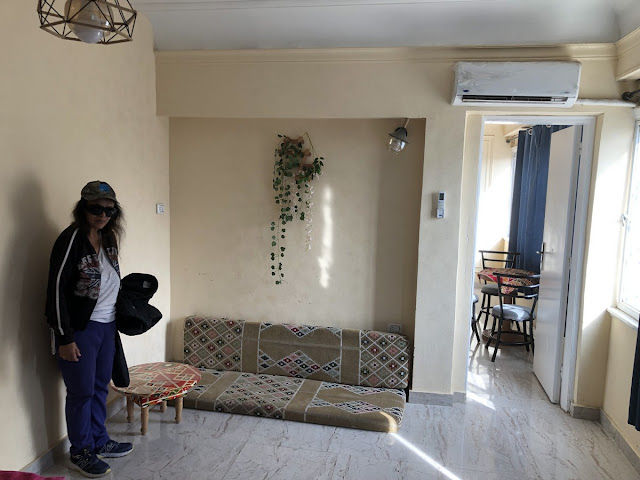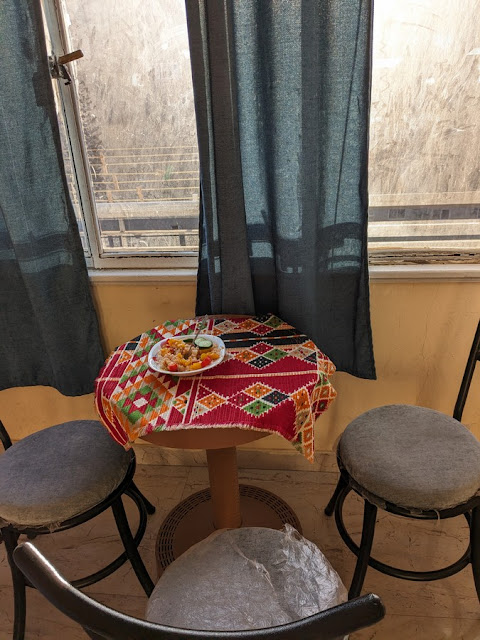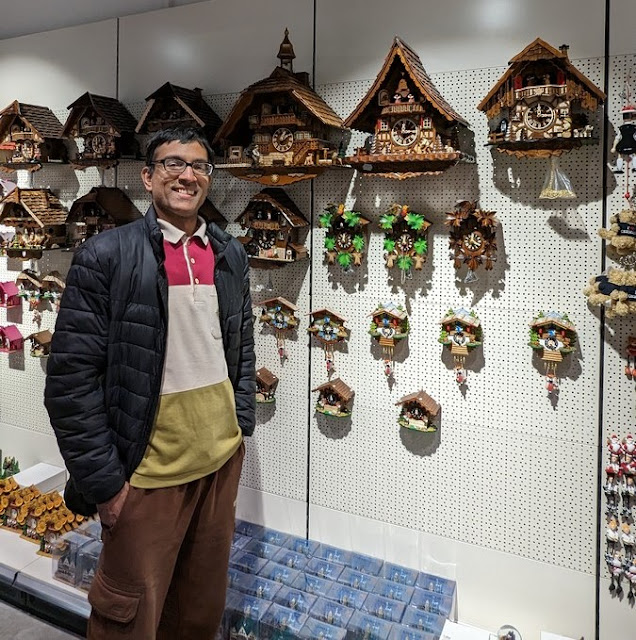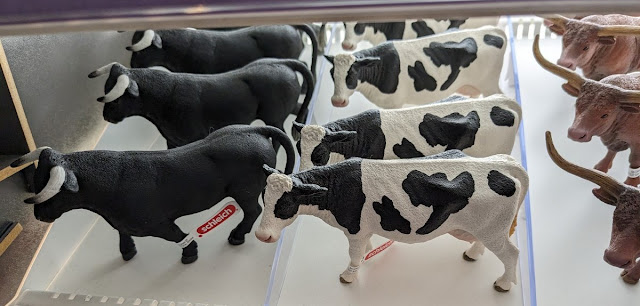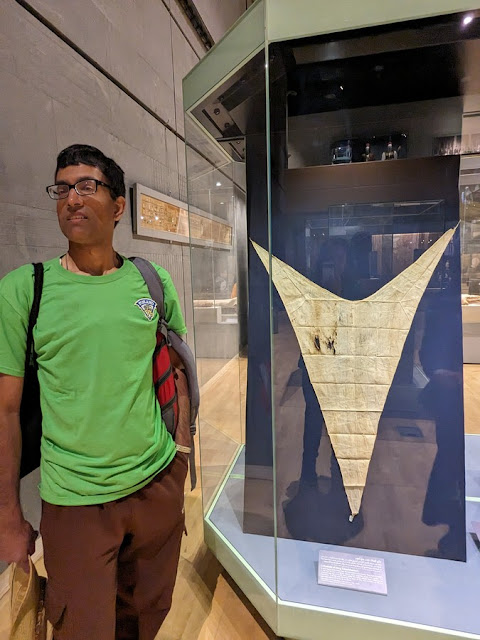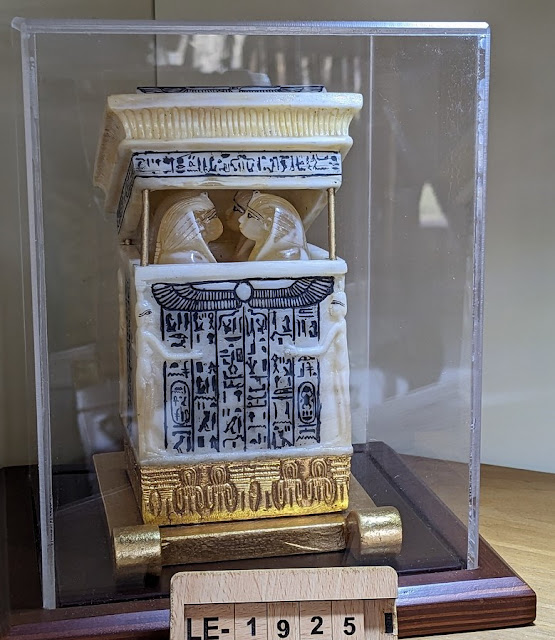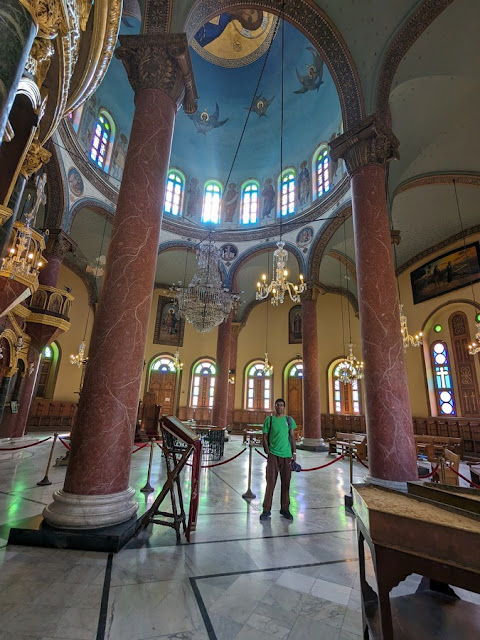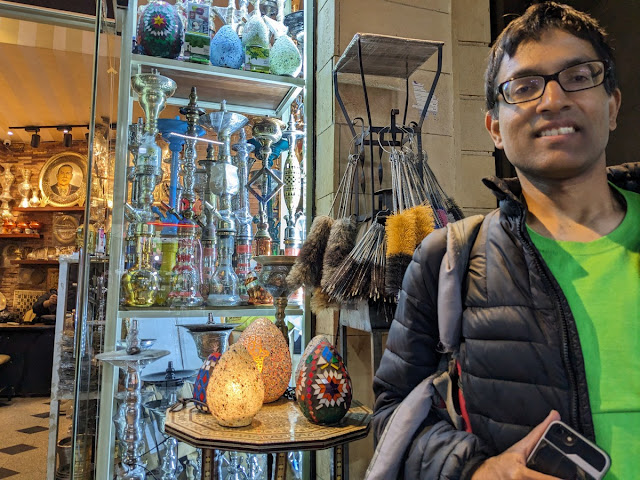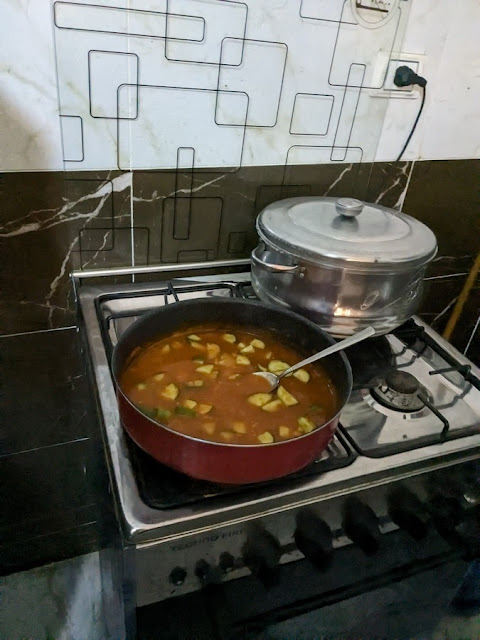
Day 16 Saturday Dec 9
Cairo National museum of Egyptian civilization NMEC, Coptic CAIRO [St George's church, Hanging church], ISLAMIC Cairo: Uber to Bab el Futuh at 8pm, walk from Bab el Futuh to Khan el Kalili
National Museum of Egyptian Civilization (NMEC)
The museum displays a collection of 50,000 artifacts, presenting the Egyptian civilization from prehistoric times to the present day. 22 mummies, including 18 kings and four queens,
Robe of a Coptic priest with saints embroidered
IVORY INLAY ON WOOD
MOSAIC
pattern or image made of small regular or irregular pieces of colored stone, glass or ceramic, held in place by plaster/mortar
MISHRABIYYAH with intricate wood lattice work
silver inlay
Islamic metalwork
Below is the Kiswah Cover for the holy kaaba... kaaba's interior has three pillars supporting the roof and a number of suspended silver and gold lamps. During most of the year the Kaaba is covered with an enormous cloth of black brocade, the kiswah.
Child birth with the assistance of Goddesses
Grave goods... furniture, clothes , food and ushabtis [servants] for afterlife buried with the mummy
Tut Ankh Amun's loin cloth
Isis spreading her wings in protection... gold amulet
EXQUISITE DECORATIVE ITEMS

We saw the royal mummies as well... no pics allowed and we did not want any either.
SOUVENIR SHOP with excellent replicas
we had not packed any lunch as we could not buy bread. we had croissants and muffins at the museum cafe
Ain al sira Lake
COPTIC CAIRO
Copts are a Christian ethnoreligious group indigenous to North Africa who have primarily inhabited the area of modern Egypt and Sudan since antiquity. We had seen the Coptic museum on Dec 11 using our Cairo pass. It would have made logistic sense to see the coptic churches nearby but we wanted to see the Citadel as well with the pass, so we had gone on there.
The churches are free
St George's church
Church of St. George (Greek: Εκκλησία Αγίου Γεωργίου; Arabic: كنيسة القديس جورج) is a Greek Orthodox church within the Babylon Fortress in Coptic Cairo.
St. George’s Church was built in the 10th century on top of the north tower of the Roman fortress. It is the seat of the Greek Patriarchate of Alexandria. The Church is dedicated to St. George
St. George was killed in 303 AD during a battle a Greek emperor fought against Christianity.
The church dates back to the 10th century (or earlier). The current structure was rebuilt following a 1904 fire, construction was finished in 1909
St. George killing a dragon
Bells
Mosaic
HANGING CHURCH
The Hanging Church/ Al-Moallaqa was built on the southern gate of the Roman Fortress. Logs of palm trees and layers of stones were constructed above the ruins of the Roman fortress to be used as a fundament. It has a wooden roof in the shape of Noah’s ark. From the 7th century to the 13th century, the Hanging Church served as the residence of the Coptic Patriarch
The impressive pulpit of the Hanging Church is from the 5th century and rests on 15 gracile columns. On each side of the pulpit a cross is depicted above three steps symbolizing the three days during which Jesus Christ was in his tomb and his resurrection.
There is an icon of St. Mark on the southern wall of the main church (St. Mark is the first Patriarch of the Coptic Orthodox Church).
A total of 110 icons are kept in the Hanging Church, the oldest of which is the “Coptic Mona Lisa” dating back to the 8th century A.D. and representing Virgin Mary, Jesus Christ and John the Baptist. Numerous altar icons date back to the 18th century A.D.
Beside these sanctuaries is the baptistery.
There is also a fresco on the eastern wall of the chapel showing the Nativity (the birth of Christ) and the mid wife Salome, next to it a second fresco of 24 men of the apocalypse. Furthermore, on the first floor a church dedicated to St. Mark.
There are three sanctuaries at the eastern side of the church, the one in the middle is dedicated to the Virgin Mary, the one to the left is named after St. George and the one to the right is named after John the Baptist.
Inside the sanctuaries painted baldachins are placed above the altars.
The wooden screen is a unique piece of art and richly decorated with geometric patterns and crosses in ebony and ivory.
The wooden screen is crowned by precious icons, in the center the enthroned Jesus, on the left side the Virgin Mary, Archangel Gabriel and St. Peter, on the right side John the Baptist, Archangel Michael and St. Paul.
15 icons describe the life and torture of St. George, 7 icons give an insight into the life of John the Baptist.
There is a door at the south-eastern corner of the church leading to the oldest part of the building. This part has three sanctuaries at the eastern side. The one in the middle is called after St. Dimiana, the one to the left is named after St. Takla Hymanot (an Ethiopian saint), and the one to the right is named after St. Andrew.
we tried to call uber to go visit Gayer-Anderson Museum... 7 drivers canceled on us... so much time wasted. Probably they may not get a ride back from there
We were fed up, called uber to drop us at our apartment. Since it's downtown, obviously we got a ride.
we had the famous icecreams at El Abd
ISLAMIC CAIRO
Al-Mu'izz Street/ El Mo'ez St
The street is currently the largest open museum of Islamic antiquities in the world, and a unique heritage site that was included on the World Heritage Sites list in 1979 AD. The street's names changed over the course of history, until it was known as Al-Mu'izz Street since 1937 AD in honor of him as the founder of Cairo.
The street
extends between two gates of the old walls of Cairo, from Bab
al-Futouh in the north to Bab Zuwaila in the south, passing through
several ancient historic lanes and streets, the most famous of
which are Amir al-Jayyoush Street, al-Darb al-Asfar, Burjawan
Neighborhood, Khan al-Khalili, and al-Ghuriya.
The street includes a group of the most wonderful antiquities of Cairo, 29 antiquities, reflecting a complete impression of Islamic Egypt in the period from the tenth century until the nineteenth century AD, which begins from the Fatimid era in Egypt (358-567 AH / 969-1171 AD) until the era of Muhammad’s dynasty. Ali (1220-1372 AH / 1805-1953 AD).
The existing ruins vary between religious, residential, commercial and defense buildings, and today markets and traditional handicraft shops are lined along the street,
We took uber to Bab al-Futouh at 8 PM.... we usually never venture out that late. Turned out to be a good call as we enjoyed couple of hours. It would have been great to enter the mosques etc at day time but we were leaving the next day
Bab al-Futuh (Arabic: الفتوح باب, lit. 'Conquest Gate') is one of three remaining gates in the city wall of
the old city of Cairo, Egypt. It is located at the northern end of al-Mu'izz Street.
The other two remaining gates are Bab al-Nasr (Victory Gate) in the north and Bab Zuwayla (Gate of Zuwayla) in the south.
The gate was built during the Fatimid period, originally in the 10th century, then rebuilt in its
current form in the late 11th century.
The gate is 22 metres (72 ft) tall 23 metres (75 ft) wide. The lower two thirds of the gate are built in
solid stone, while the upper third was built in rubble stone encased in by solid, finely dressed stone. The
gate has a defensive design and its entrance is flanked by two tall towers of round shape. Its
decoration and craftsmanship are more extensive and of higher quality than that of nearby Bab al-Nasr.
The details of its stonework also suggest the influence of northern Syrian or Byzantine architectural
traditions or craftsmen.
Khan al Khalili Bazaar at its festive best with music and weekend crowds
.... Dervish dancing,
guy on stilt dancing....
Alladdin lamps...
nuts, dry fruits
gold
we walked out after 10.30, called uber and went back to the apartment
Report continues HERE





